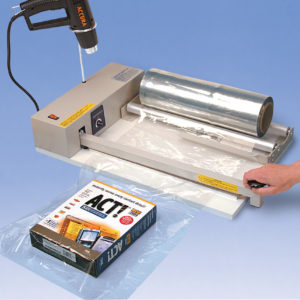 Shrink wrap is something that consumers frequently encounter, but rarely consider. Businesses, on the other hand, must carefully consider the use of shrink wrap materials and devices and how they are used in packaging.
Shrink wrap is something that consumers frequently encounter, but rarely consider. Businesses, on the other hand, must carefully consider the use of shrink wrap materials and devices and how they are used in packaging.
Shrink wrap can be used to wrap food, package retail products, and provide the finishing touches to goods produced in industrial manufacturing plants. Items as large as cars and buildings can be shrink wrapped. The uses of this incredible product are many and varied; therefore modern businesses have many options for using shrink wrap in their daily operations.
Where did shrink wrap come from? What is it made of? How can businesses benefit from the use of shrink wrap? Here are a few basics about retail shrink wrap systems.
History
Several companies have claimed to be the first to introduce a shrink wrap product or process; however, the concept and usage of shrink wrap appears to have originated with W.R. Grace & Company, a conglomerate that started in the mid-1800s shipping fertilizer (guano) out of South America, and diversified during a century and a half to include travel, food, apparel, and notably, chemicals.
In 1954, W.R. Grace & Company purchased Dewy & Almy Chemical Company, spinning off Cryovac as a separate subsidiary. In 1960, they introduced Cryovac Type L shrink wrap, which was used for meat and poultry products. Since then, the market for shrink wrap products and devices has grown considerably, and businesses can now use anything from small, handheld sealing devices up to automated, industrial conveyor belt and oven systems that wrap large packages or multiple packages at a time.
Composition
There are a variety of different materials used for the purposes of shrink wrapping, but all are made of polymer plastic film that shrinks when heated. Common materials used in shrink wrapping include polyvinyl chloride (PVC), polyethylene, polypropylene, and polyolefin.
Polyolefin shrink wrap is preferred for a number of reasons. It provides a stronger and more flexible seal than some other materials and lacks the odor associated with PVC shrink wrap. Because it contains no chlorine, there is no risk of off-gassing of hydrogen chloride gas during the sealing process (as with PVC). Plus, the lack of plasticizers means that polyolefin products can be stored in a variety of temperature settings without risking the same hardening or softening that can plague PVC shrink wrap.
Unfortunately, there are a couple of issues with polyolefin; namely, it tends to be more expensive than PVC and it can be incompatible with existing shrink wrap machinery.
Benefits
Not every business needs shrink wrap. A company that offers only services (as opposed to goods) probably has little need for even a rudimentary shrink wrap system. The devices and materials used for shrink wrapping, however, can be extremely useful to companies that manufacture, package, and sell goods.
The important thing to consider is what type of shrink wrap system is right for your particular business. If you’re selling pre-made sandwiches or baked goods, for example, you’re going to need different equipment and materials (that meet food industry standards) than, say, someone who is wrapping toy packaging, DVDs, or pallets of auto parts.
In any case, the greatest benefit of using shrink wrap is that it protects the contents by sealing them, reducing contaminants and, in some cases, increasing longevity. It ensures that items have not been tampered with prior to purchase and makes it easy to bundle and ship products. It is also transparent, allowing you to verify the contents at a glance and making inventory much easier to track.
Shrink wrapping may also be considerably more cost-effective than some other packaging methods, and products may take up less storage space. There are many benefits to explore when considering shrink wrap solutions for your retail operation.
